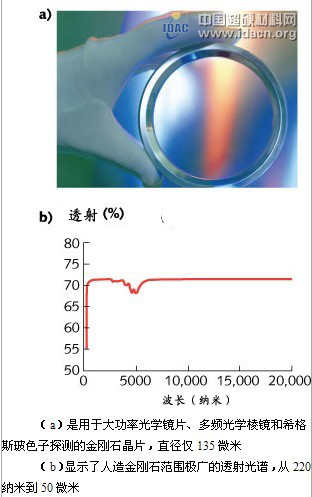Abstract In the heat dissipation application of photovoltaic components, synthetic diamonds have defeated similar materials such as copper and silicon carbide with superior heat dissipation performance, enabling semiconductor manufacturers to produce optoelectronic devices with smaller volume, faster heat dissipation rate and higher power; Laser diodes use synthetic diamond material...
In the heat dissipation application of photovoltaic components, synthetic diamonds have defeated similar materials such as copper and silicon carbide with superior heat dissipation performance, enabling semiconductor manufacturers to produce optoelectronic devices with smaller volume, faster heat dissipation rate and higher power; such as laser After the use of synthetic diamond material, the life of the device is extended and the stability of the work is improved. However, the application of diamonds in high-tech fields is not just for heat dissipation. The controlled growth environment of synthetic diamonds makes high-end technology such as high-power optical window lenses, multi-frequency optical prisms and Higgs boson detection a reality.
As a global leader in the development of synthetic diamonds, Element Six uses its patented technology to grow single crystal diamonds and polycrystalline diamonds from hydrocarbon gas mixtures using chemical vapor deposition. Henk de Wit, Business Manager of Optics at Element Six, said: "To customize products with special needs, we have maximized the removal of chemical impurities in diamonds and designed various application properties into the diamond. Using microwave CVD, High quality polycrystalline diamond and single crystal diamond can be obtained by heating the gas mixture at a temperature higher than 2000 °C.
As early as February of this year, Element Six expanded its Silicon Valley equipment and increased the mass production capacity of synthetic diamond optical window wafers; optical window lenses are an important component device in laser plasma EUV lithography systems, which account for the entire light. The engraved system consists of 50% of the components. The process of expanding production capacity allows high quality diamond wafers to reach a size level of 135 microns in diameter (see figure below).

The high thermal conductivity makes synthetic diamond the best material for optical window lenses. It can be used for high-power CO2 lasers above 6 kW. In fact, synthetic diamond is the only one capable of withstanding more than 8 kW (up to 35). Kilowatts of material. The minimal wavefront distortion allows diamond lenses to be used in extreme UV lithography systems. Compared with materials with low thermal conductivity such as zinc selenide, the heat generated by light absorption is transmitted to the external environment through the high thermal conductivity diamond, thereby preventing the formation of thermal focus, protecting other devices, and also eliminating The compensation of the thermal lens effect.
Spectral prism
In the components of the Fourier transform infrared spectrometer, the sample holder is made of synthetic diamond. The mounted CVD single crystal diamond attenuated total reflection (ATR) prism has the widest transmission spectrum from 220 nm to 50 microns, which greatly improves the measurement sensitivity, analysis range and accuracy of the prism. Multi-frequency projection spectroscopy incorporating diamond technology enables spectrometer manufacturers to produce compact devices with relatively simple internal optical systems. At the same time, the scratch-resistant and biochemically inert nature of synthetic diamonds allows the CVD diamond spectrometer to be used in harsh environments, and its durability is much superior to conventional spectral prisms.
Particle detection
The high-purity CVD synthetic diamond produced by Element Six is ​​also an important component of the CERN Large Hadron Collider CMS experiment and the ATLAS monitoring system. It is used to detect a new particle that scientists have just discovered. This particle is very similar to the Higgs boson. Synthetic diamond acts as a sensor for safety detection in this device, and can withstand harsh, high-radiation environments; it also reacts instantly to protect advanced and expensive measurement systems.
CERN scientist Anna Dabrowski, who is in charge of the CMS experiment, said: "Our CMS experiments rely on the stability of synthetic diamonds to monitor the beam of the Large Hadron Collider and the particles produced during the collision. This diamond-based system Stability plays an important role in protecting sensitive components of 66,000,000 channel pixel tracking." (Compiled from "NOVEL MATERIALS: Synthetic diamond offers much more than heat sinking")
Steel poles are commonly used to carry several types of electric power lines, distribution lines and lighting system. Distribution lines carry power from local substations to customers. They generally carry voltages from 4.6 to 33kV for distances up to 30 miles, and include transformers to step the voltage down from the primary voltage to the lower secondary voltage used by the customer. A service drop carries this lower voltage to the customer's premises.
LED Lamp,High Brightness LED Lamp,Led Street Bulbs Lamp,LED Wall Lamps
Yixing Steel Pole International Trading Co., Ltd , http://www.yx-steelpole.com